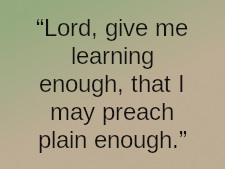Illustrations in Preaching, Part 1
Image

Third Series of Lectures to My Students
The Art of Illustration: Being Addresses Delivered ot the students of The Pastor’s College, Metropolitan Tabernacle
By C. H. Spurgeon, 1905*
Lecture 1: Illustrations in Preaching
The topic now before us is the use of illustrations in our sermons. Perhaps we shall best subserve our purpose by working out an illustration in the present address; for there is no better way of teaching the art of pottery than by making a pot. Quaint ‘Thomas Fuller says, “reasons are the pillars of the fabric of a sermon; but similitudes are the windows which give the best lights.” The comparison is happy and suggestive, and we will build up our discourse under its direction.
The chief reason for the construction of windows in a house is, as Fuller says, to let in light. Parables, similes, and metaphors have that effect; and hence we use them to illustrate our subject, or, in other words, to “brighten it with light,” for that is Dr. Johnson’s literal, rendering of the word illustrate.
Often when didactic speech fails to enlighten our hearers we may make them see our meaning by opening a window and letting in the pleasant light of analogy. Our Savior, who is the light of the world, took care to fill his speech with similitudes, so that the common people heard him gladly: his example stamps with high authority the practice of illuminating heavenly instruction with comparisons and similes. To every preacher of righteousness as well as to Noah, wisdom gives the command, “A window shalt thou make in the ark.”
You may build up laborious definitions and explanations and yet leave your hearers in the dark as to your meaning; but a thoroughly suitable metaphor will wonderfully clear the sense. The pictures in The Illustrated London News give us a far better idea of the scenery which they represent than could be conveyed to us by the best descriptive letter-press; and it is much the same with Scriptural teaching: abstract truth comes before us so much more vividly when a concrete example is given, or the doctrine itself is clothed in figurative language. There should, if possible, be at least one good metaphor in the shortest address; as Ezekiel, in his vision of the temple, saw that even to the little chambers there were windows suitable to their size.
If we are faithful to the spirit of the gospel we labor-to make things plain: it is our study to be simple and to be understood by the most illiterate of our hearers; let us, then, set forth many a metaphor and parable before the people. He wrote wisely who said, “The world below me is a glass in which I may see the world above. The works of God are the shepherd’s calendar and the ploughman’s alphabet.”
Having nothing to conceal, we have no ambition to be obscure. Lycophron declared that he would hang himself upon a tree if he found a person who could understand his poem entitled “The Prophecy of Cassandra.” Happily no one arose to drive him to such a misuse of timber. We think we could find brethren in the ministry who might safely run the same risk in connection with their sermons. Still have we among us those who are like Heraclitus, who was called “the Dark Doctor” because his language was beyond all comprehension. Certain mystical discourses are so dense that if light were admitted into them it would be extinguished like a torch in the Grotta del Cane: they are made up of the palpably obscure and the inexplicably involved, and all hope of understanding them may be abandoned.
This style of oratory we do not cultivate. We are of the same mind as Joshua Shute, who said: “That sermon has most learning in. it that has most plainness. Hence it is that a great scholar was wont to say, ‘Lord, give me learning enough, that I may preach plain enough.’”
* Editor’s note: additional paragraph breaks have been added here to the 1905 edition.
- 15 views


Discussion